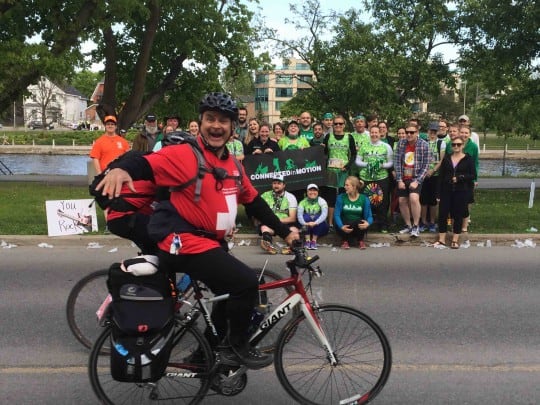
Words by Anne Marie Hospod
So you made it! It’s race day! You trained for months and are healthy and injury free. Wahoo! You’re ready to tackle your first, third, or fiftieth race, and you’re getting excited!
Race days are special. From the crowd support to the start line adrenaline (you’ll likely need more insulin), from the endorphins to unpredictable diabetes hiccups, race days are memorable.
The very first race that I did was a marathon. I likely should have raced at least a 5k before to prepare myself for the changes in my diabetes or nutrition management. I trained a lot, and even tried to practice the exact same wake-ups and strategies as race day. I got up at 5am (marathons tend to start early!), went out for my long run, and carried all of my water and nutrition with me, not to mention all of my diabetes supplies. At the time I was using insulin pens, and so carried all sorts of extra supplies in an oh-so-classy fanny pack. I was a racing newbie and a control freak when it came to my diabetes. I wanted to be uber-prepared and even though I knew that there would be aid stations available, I wanted to have easy access to everything that I may or may not need during the 42.2 km.
Other than some tweaks to my diabetes management to account for the race nerves, race day in my mind would be a training day with other people. Ok, a lot of people. I had no idea though that there were so many unspoken rules to running road races – who knew?!
Fast forward almost ten years since this first marathon – I have completed 3 marathons, 10 or so half marathons, numerous 10 and 5km fun races, a couple of short and long distance triathlons, and now am training for a full Ironman. I know the rules, and try me best to be a courteous racer.
So what have I learned? How are races different from training days? What are these rules of road racing? Let’s get started!
Don’t be a race bandit
Cities and organizers work tirelessly to ensure that the race will be safe for all participants, and one way that they ensure your safety is by capping the number of runners. Runners are also a very respectful bunch, so showing up and running alongside others who have paid for their bib is simply disrespectful. Medical resources could be strained if there are too many runners, or medals could run out for the slower paced participants.
Be realistic – place yourself in the right corral.

If your best half marathon time is 2:25, and your training has been consistent in the last few months, don’t place yourself in the 1:59 corral group. You’ll have other runners try to get ahead, and you will either start off too fast or mentally feel like you are too slow – both not good things to happen early on in a long race. Be realistic and you’ll enjoy the experience so much more!
Don’t form a chain link with your friends. Let others pass .
Running with friends is amazing – you get to enjoy the whole experience from start to finish together, and can motivate each other as one of you falls off pace. Just remember, road races can become quite congested, especially at the start and around turns, so be courteous and switch to a vertical, follow-the-leader, running pattern for those moments. Others will thank you.
Walking or stopping? Go to the side of the road.
Don’t stop unexpectedly. Put your hand or arm out to show your intent, then take a step to the side of the road, then stop or walk. If you’re used to training solo, this is especially important to remember.
Don’t run-selfie please.

I’m all for documenting your race and capturing the fun, silly, challenging times with a well-timed selfie. That said, other runners don’t expect a random arm to fling out. I tend to take pictures at the start or at the finish only. If I really want to take a picture during a fun run I will go to the side of the road first
Don’t be a litter bug. Wait, and place.
Wait for an aid station and place your trash – from tissues to snacks to test strips – in the bins by the aid stations. Can’t see a trash bin? The next best thing is to place your trash on the road by the aid stations, making the job for the volunteers that much easier.
Thank the volunteers
 Great races are due in large part to the amazing volunteers who wake up early and stay late, who high-five and cheer, who want to see you succeed. Tell them thanks and genuinely show your appreciation. They will be fundamental in making your race a positive experience.
Great races are due in large part to the amazing volunteers who wake up early and stay late, who high-five and cheer, who want to see you succeed. Tell them thanks and genuinely show your appreciation. They will be fundamental in making your race a positive experience.
Have fun!
One of the most important things to remember is to have fun! You have trained hard for this race and whether it’s your first, third, or fiftieth race, you deserve to enjoy the whole experience. Tie up those laces and enjoy!
 Diagnosed at the age of four with Type 1 diabetes, Anne has learned to adapt from an early age. She lives with a positive and balanced outlook and knows that her chronic condition does not define her. She believes in surrounding herself with inspiring individuals and spreading gratitude and joy. She hopes to inspire others to realize that there is strength in vulnerability and power in positive thinking. She has been chosen as a Diabetes Sports Project Champion as she trains for a full Ironman this August.You can follow her journey on her training blog, Iron Lady Anne.
Diagnosed at the age of four with Type 1 diabetes, Anne has learned to adapt from an early age. She lives with a positive and balanced outlook and knows that her chronic condition does not define her. She believes in surrounding herself with inspiring individuals and spreading gratitude and joy. She hopes to inspire others to realize that there is strength in vulnerability and power in positive thinking. She has been chosen as a Diabetes Sports Project Champion as she trains for a full Ironman this August.You can follow her journey on her training blog, Iron Lady Anne.




